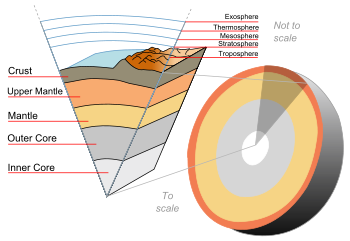- Outer core
-
 Earth cutaway from core to exosphere. Partially to scale
Earth cutaway from core to exosphere. Partially to scale
The outer core of the Earth is a liquid layer about 2,266 kilometers thick composed of iron and nickel which lies above the Earth's solid inner core and below its mantle. Its outer boundary lies 2,890 km (1,800 mi) beneath the Earth's surface. The transition between the inner core and outer core is located approximately 5,150 km beneath the Earth's surface.
The temperature of the outer core ranges from 4400 °C in the outer regions to 6100 °C near the inner core. Because of its high temperature, modeling work has shown that the outer core is a low viscosity fluid (about ten times the viscosity of liquid metals at the surface) that convects turbulently.[1] Eddy currents in the nickel iron fluid of the outer core are believed to influence the Earth's magnetic field. The average magnetic field strength in the Earth's outer core was measured to be 25 Gauss, 50 times stronger than the magnetic field at the surface.[2][3] The outer core is not under enough pressure to be solid, so it is liquid even though it has a composition similar to that of the inner core. Sulfur and oxygen could also be present in the outer core.
As heat is transferred outward toward the mantle, the net trend is for the inner boundary of the liquid region to freeze, causing the solid core to grow.[4] This growth rate is estimated to be 1 mm per year.[5]
Without the outer core, life on Earth would be very different. Convection of liquid metals in the outer core creates the Earth's magnetic field.[6][7] This magnetic field extends outward from the Earth for several thousand kilometers, and creates a protective bubble around the Earth that deflects the Sun's solar wind. Without this field, the solar wind would directly strike the Earth's atmosphere. This could potentially have slowly removed the Earth's atmosphere, rendering it nearly lifeless, as is hypothesized for Mars.[8]
The low viscosity of the outer core is important in seismology because low-viscosity fluids can not sustain shear stresses: their rapid deformation in response to shear stresses causes the stresses to go to zero. Therefore, s-waves attenuate completely in the outer core, and the only s-waves that appear after a wave exits the outer core do so due to splitting of p-waves into an s-wave component.
See also
References
- ^ Gilles A. de Wijs et. al., The viscosity of liquid iron at the physical conditions of the Earth's core, Nature 392, 805-807 (23 April 1998) . 392. doi:10.1038/33905.
- ^ http://www.science20.com/news_articles/first_measurement_magnetic_field_inside_earths_core
- ^ http://www.nature.com/nature/journal/v468/n7326/full/nature09643.html
- ^ Gubbins, David; Sreenivasan, Binod; Mound, Jon; Rost, Sebastian (May 19, 2011), "Melting of the Earth’s inner core", Nature 473: 361–363, doi:doi:10.1038/nature10068
- ^ Waszek, Lauren; Irving, Jessica; Deuss, Arwen (February 20, 2011), "Reconciling the hemispherical structure of Earth’s inner core with its super-rotation", Nature Geoscience 4: 264–267, doi:doi:10.1038/ngeo1083
- ^ Woodrow L. Shew, Daniel P. Lathrop, Liquid sodium model of geophysical core convection, Physics of the Earth and Planetary Interiors 153 (2005) 136–149
- ^ Kent C. Condie, Plate Tectonics, Butterworth-Heinemann; 4th ed., 1997, p. 140 ISBN 978-0750633864
- ^ http://scign.jpl.nasa.gov/learn/plate1.htm
External links
Earth-related topics History Geography
and geologyEcology - Earth Day
- Gaia philosophy
- Global warming
- Human impact on the environment
- Millennium Ecosystem Assessment
Imaging Arts, culture
and society- Earth in culture
- Earth in fiction
- Etymology of the word "Earth"
- Flat Earth and Hollow Earth
- History of the world
- International law
- Landscape art
- List of countries
- World economy
Spirituality
and teleology- Creation myth
- Creationism
- Earth Mother
- Gaia (Ancient Greece)
- New Age Gaian
- Planetary Logos (Theosophy)
- Tellus Mater (Ancient Rome)
- Earth sciences portal
- Solar System portal
Shells Discontinuities Arguments Categories:- Structure of the Earth
- Geomagnetism
- Geophysics stubs
Wikimedia Foundation. 2010.
